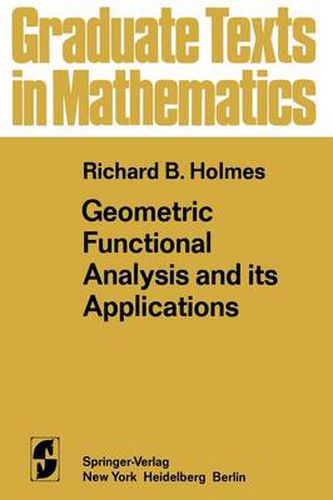Readings Newsletter
Become a Readings Member to make your shopping experience even easier.
Sign in or sign up for free!
You’re not far away from qualifying for FREE standard shipping within Australia
You’ve qualified for FREE standard shipping within Australia
The cart is loading…






This title is printed to order. This book may have been self-published. If so, we cannot guarantee the quality of the content. In the main most books will have gone through the editing process however some may not. We therefore suggest that you be aware of this before ordering this book. If in doubt check either the author or publisher’s details as we are unable to accept any returns unless they are faulty. Please contact us if you have any questions.
This book has evolved from my experience over the past decade in teaching and doing research in functional analysis and certain of its appli cations. These applications are to optimization theory in general and to best approximation theory in particular. The geometric nature of the subjects has greatly influenced the approach to functional analysis presented herein, especially its basis on the unifying concept of convexity. Most of the major theorems either concern or depend on properties of convex sets; the others generally pertain to conjugate spaces or compactness properties, both of which topics are important for the proper setting and resolution of optimization problems. In consequence, and in contrast to most other treatments of functional analysis, there is no discussion of spectral theory, and only the most basic and general properties of linear operators are established. Some of the theoretical highlights of the book are the Banach space theorems associated with the names of Dixmier, Krein, James, Smulian, Bishop-Phelps, Brondsted-Rockafellar, and Bessaga-Pelczynski. Prior to these (and others) we establish to two most important principles of geometric functional analysis: the extended Krein-Milman theorem and the Hahn Banach principle, the latter appearing in ten different but equivalent formula tions (some of which are optimality criteria for convex programs). In addition, a good deal of attention is paid to properties and characterizations of conjugate spaces, especially reflexive spaces.
$9.00 standard shipping within Australia
FREE standard shipping within Australia for orders over $100.00
Express & International shipping calculated at checkout
This title is printed to order. This book may have been self-published. If so, we cannot guarantee the quality of the content. In the main most books will have gone through the editing process however some may not. We therefore suggest that you be aware of this before ordering this book. If in doubt check either the author or publisher’s details as we are unable to accept any returns unless they are faulty. Please contact us if you have any questions.
This book has evolved from my experience over the past decade in teaching and doing research in functional analysis and certain of its appli cations. These applications are to optimization theory in general and to best approximation theory in particular. The geometric nature of the subjects has greatly influenced the approach to functional analysis presented herein, especially its basis on the unifying concept of convexity. Most of the major theorems either concern or depend on properties of convex sets; the others generally pertain to conjugate spaces or compactness properties, both of which topics are important for the proper setting and resolution of optimization problems. In consequence, and in contrast to most other treatments of functional analysis, there is no discussion of spectral theory, and only the most basic and general properties of linear operators are established. Some of the theoretical highlights of the book are the Banach space theorems associated with the names of Dixmier, Krein, James, Smulian, Bishop-Phelps, Brondsted-Rockafellar, and Bessaga-Pelczynski. Prior to these (and others) we establish to two most important principles of geometric functional analysis: the extended Krein-Milman theorem and the Hahn Banach principle, the latter appearing in ten different but equivalent formula tions (some of which are optimality criteria for convex programs). In addition, a good deal of attention is paid to properties and characterizations of conjugate spaces, especially reflexive spaces.